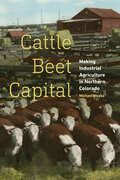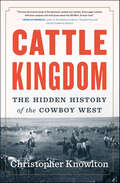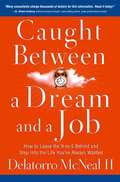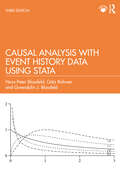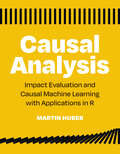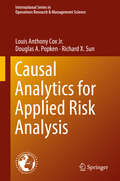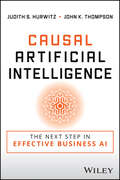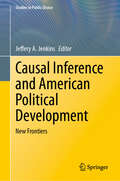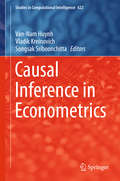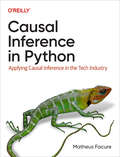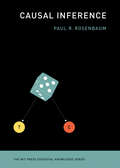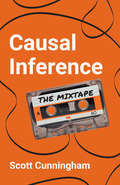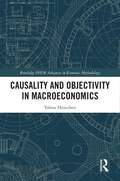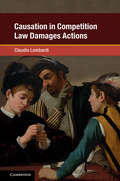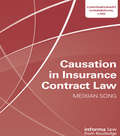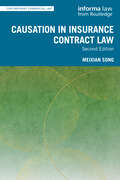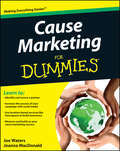- Table View
- List View
Catfight: Women and Competition
by Leora TanenbaumCatfight: Women and Competition is Leora Tanenbaum's dissection of the gender war waged among women. Tanenbaum meticulously analyzes the roots of destructive competitiveness among women, asserting that "catfights" thrive because, despite women's many gains, American women are conditioned to regard each other as adversaries rather than allies. She investigates the arenas-from diets to dating, from the boardroom to the delivery room- in which American women are apt to compare their lives with the lives of others in a tacit contest over who is the "better" woman, a contest in which no one wins. Throughout Catfight, Leora Tanenbaum puts her own life experiences under the lens of scrutiny. As a writer, a friend, a mother, a wife, and a daughter, she analyzes her own insecurities and background and how these influence her relations with other women. With the sociologist's perspective of a Barbara Ehrenreich and the feminist outrage of a Gloria Steinem, Tanenbaum demythologizes the age-old "catfight."
Cathay Pacific
by F. Warren Mcfarlan Fred Young Lo WaishunExplores the various aspects of information technology that can be outsourced. Cathay Pacific outsourced a significant part of its vital operations from Hong Kong to Sydney, Australia.
Cathay Pacific: Doing More with Less
by F. Warren Mcfarlan Fred YoungThis case explores the various aspects of information technology that can be outsourced. Cathay Pacific outsourced a significant part of its vital operations from Hong Kong to Sydney, Australia.
Catherine the Great, CEO: 7 Principles to Guide & Inspire Modern Leaders (CEO)
by Alan AxelrodIn this sixth volume of Alan Axelrods popular CEO series, he dispenses the wisdom of a female monarch for the first time since his Businessweek bestseller Elizabeth I, CEO. Catherine the Great traveled from Germany to Russia at only 14 years of age, and rose to become one of the most remarkable, powerful, and captivating rulers in history. Axelrod profiles this strong and beloved leader, examining her qualities of intellect, heart, and character, and distilling her words and actions into more than 100 practical and modern leadership lessons. Women, in particular, will appreciate this study of a role model—one of only two Russian tsars ever to earn the title “Great.”
Cathy Can't Contain Herself: Overcoming an Individual's Immunity to Change
by Lisa Laskow Lahey Robert KeganIssues with self-management and emotional self-regulation at work are widespread and can prevent even the brightest people, like Cathy, from realizing their full potential. This chapter examines how Cathy came to understand that she both created and was captive to high levels of stress in her work life. As her story illustrates, understanding the source is the first step toward overcoming your immunity to change. This chapter is excerpted from "Immunity to Change: How to Overcome It and Unlock the Potential In Yourself and Your Organization."
Cattle Beet Capital: Making Industrial Agriculture in Northern Colorado
by Michael WeeksIn 1870 several hundred settlers arrived at a patch of land at the confluence of the South Platte and Cache la Poudre Rivers in Colorado Territory. Their planned agricultural community, which they named Greeley, was centered around small landholdings, shared irrigation, and a variety of market crops. One hundred years later, Greeley was the home of the world&’s largest concentrated cattle-feeding operation, with the resources of an entire region directed toward manufacturing beef. How did that transformation happen? Cattle Beet Capital is animated by that question. Expanding outward from Greeley to all of northern Colorado, Cattle Beet Capital shows how the beet sugar industry came to dominate the region in the early twentieth century through a reciprocal relationship with its growers that supported a healthy and sustainable agriculture while simultaneously exploiting tens of thousands of migrant laborers. Michael Weeks shows how the state provided much of the scaffolding for the industry in the form of tariffs and research that synchronized with the agendas of industry and large farmers. The transformations that led to commercial feedlots began during the 1930s as farmers replaced crop rotations and seasonal livestock operations with densely packed cattle pens, mono-cropped corn, and the products pouring out of agro-industrial labs and factories. Using the lens of the northern Colorado region, Cattle Beet Capital illuminates the historical processes that made our modern food systems.
Cattle Kingdom: The Hidden History of the Cowboy West
by Christopher Knowlton“The best all-around study of the American cowboy ever written. Every page crackles with keen analysis and vivid prose about the Old West. A must-read!” —Douglas Brinkley, The New York Times–bestselling author of The Wilderness Warrior: Theodore Roosevelt and the Crusade for AmericaThe open-range cattle era lasted barely a quarter century, but it left America irrevocably changed. Cattle Kingdom reveals how the West rose and fell, and how its legacy defines us today. The tale takes us from dust-choked cattle drives to the unlikely splendors of boomtowns like Abilene, Kansas, and Cheyenne, Wyoming. We meet a diverse cast, from cowboy Teddy Blue to failed rancher and future president Teddy Roosevelt. This is a revolutionary new appraisal of the Old West and the America it made.“Cattle Kingdom is the smartly told account of rampant capitalism making its home—however destructive and decidedly unromantic—on the range. . . . [A] fresh and winning perspective.” —The Dallas Morning News“Knowlton writes well about all the fun stuff: trail drives, rambunctious cow towns, gunfights and range wars . . . [He] enlists all of these tropes in support of an intriguing thesis: that the romance of the Old West arose upon the swelling surface of a giant economic bubble . . . Cattle Kingdom is The Great Plains by way of The Big Short.” —Wall Street Journal“Knowlton deftly balances close-ups and bird’s-eye views. We learn countless details . . . More important, we learn why the story played out as it did.” —The New York Times Book Review“The best one-volume history of the legendary era of the cowboy and cattle empires in thirty years.” —True West“Vastly informative.” —Library Journal“Absorbing.” —Publishers Weekly
Caught Between A Dream And A Job: How To Leave The 9-to-5 Behind And Step Into The Life You've Always Wanted
by Delatorro McNealDelatorro McNeal wants to help you move from "just a paycheck" to a life of significance, meaning, and excitement; a life of hope and expectation. Through the interactive questions and activities, motivating quotes, and realistic and doable transition strategies. Caught Between a Dream and a Job will help you discover all that is possible for you as you learn to: · Define true success for yourself · Frame your work around your life--instead of the other way around · Become the person that you have always wanted to be by setting the extraordinary as your new standard · Systematically move from job living to dream living · Do what you love to do--and get paid to do it Your work was never meant to be just a job. You are a blessed, uniquely special individual with tremendous gifts, talents, abilities, and skills that were designed to solve problems and transform lives in this world. Get started today and discover the life you were made for!
Caught Up in Emotions: How to Handle Fear, Anger, and Embarrassment in Difficult Conversations
by Holly WeeksDifficult conversations stir up crucially disturbing emotions- particularly fear, anger, and embarrassment, which combine to trap us in what the author describes as individual signature emotional states. Our own signature states replay our emotional history, often to our detriment. We can break their grip by understanding our signature states and how they come into play in tough conversations.
Caught in the Crossfire
by Jan GoodwinAn American journalist's experience in the war-torn Afghanistan, as a woman's magazine editor, not a combat reporter.
Causal Analysis with Event History Data Using Stata
by Hans-Peter Blossfeld Götz Rohwer Gwendolin J. BlossfeldThis third edition of Causal Analysis with Event History Data Using Stata provides an updated introduction to event history modeling along with many instructive Stata examples. Using the latest Stata software, each of these practical examples develops a research question, points to useful contextual background information, gives a brief account of the underlying statistical concepts, describes the organization of input data and the application of Stata statistical procedures, and assists the reader in interpreting the content of the results obtained. Emphasizing the strengths and limitations of continuous-time event history analysis in different fields of social science applications, this book demonstrates that event history models provide a useful approach to uncover causal relation- ships or to map a system of causal relationships. In particular, this book demonstrates how long-term processes can be studied, how different forms of duration dependencies can be estimated using nonparametric, parametric and semiparametric models, and how parallel and interdependent dynamic systems can be analyzed from a causal-analytical point of view using the method of episode splitting. The book also shows how changing contextual information at the micro, meso and macro levels can be easily integrated into a dynamic analysis of longitudinal data. Finally, the book addresses the problem of unobserved heterogeneity of time-constant and time-dependent omitted variables and makes suggestions for dealing with these sometimes difficult methodological problems.Causal Analysis with Event History Data Using Stata is an invaluable resource for both novice and experienced researchers from a variety of fields (e.g. sociology, economics, political science, education, psychology, demography, epidemiology, management research and organizational studies, as well as medicine and clinical applications) who need an introductory textbook on continuous-time event history analysis and who are looking for a practical handbook for their longitudinal research.
Causal Analysis: Impact Evaluation and Causal Machine Learning with Applications in R
by Martin HuberA comprehensive and cutting-edge introduction to quantitative methods of causal analysis, including new trends in machine learning.Reasoning about cause and effect—the consequence of doing one thing versus another—is an integral part of our lives as human beings. In an increasingly digital and data-driven economy, the importance of sophisticated causal analysis only deepens. Presenting the most important quantitative methods for evaluating causal effects, this textbook provides graduate students and researchers with a clear and comprehensive introduction to the causal analysis of empirical data. Martin Huber&’s accessible approach highlights the intuition and motivation behind various methods while also providing formal discussions of key concepts using statistical notation. Causal Analysis covers several methodological developments not covered in other texts, including new trends in machine learning, the evaluation of interaction or interference effects, and recent research designs such as bunching or kink designs.Most complete and cutting-edge introduction to causal analysis, including causal machine learning Clean presentation of rigorous material avoids extraneous detail and emphasizes conceptual analogies over statistical notationSupplies a range of applications and practical examples using R
Causal Analytics for Applied Risk Analysis (International Series in Operations Research & Management Science #270)
by Louis Anthony Cox Jr. Douglas A. Popken Richard X. SunCausal analytics methods can revolutionize the use of data to make effective decisions by revealing how different choices affect probabilities of various outcomes. This book presents and illustrates models, algorithms, principles, and software for deriving causal models from data and for using them to optimize decisions with uncertain outcomes. It discusses how to describe and summarize situations; detect changes; evaluate effects of policies or interventions; learn what works best under different conditions; predict values of as-yet unobserved quantities from available data; and identify the most likely explanations for observed outcomes, including surprises and anomalies. The book resents practical techniques for causal modeling and analytics that practitioners can apply to improve understanding of how choices affect probabilities of consequences and, based on this understanding, to recommend choices that are more likely to accomplish their intended objectives.The book begins with a survey of modern analytics methods, focusing mainly on techniques useful for decision, risk, and policy analysis. Chapter 2 introduces free in-browser software, including the Causal Analytics Toolkit (CAT) software, to enable readers to perform the analyses described and to apply modern analytics methods easily to their own data sets. Chapters 3 through 11 show how to apply causal analytics and risk analytics to practical risk analysis challenges, mainly related to public and occupational health risks from pathogens in food or from pollutants in air. Chapters 12 through 15 turn to broader questions of how to improve risk management decision-making by individuals, groups, organizations, institutions, and multi-generation societies with different cultures and norms for cooperation. These chapters examine organizational learning, community resilience, societal risk management, and intergenerational collaboration and justice in managing risks.
Causal Artificial Intelligence: The Next Step in Effective Business AI
by Judith S. Hurwitz John K. ThompsonDiscover the next major revolution in data science and AI and how it applies to your organization In Causal Artificial Intelligence: The Next Step in Effective, Efficient, and Practical AI, a team of dedicated tech executives delivers a business-focused approach based on a deep and engaging exploration of the models and data used in causal AI. The book’s discussions include both accessible and understandable technical detail and business context and concepts that frame causal AI in familiar business settings. Useful for both data scientists and business-side professionals, the book offers: Clear and compelling descriptions of the concept of causality and how it can benefit your organization Detailed use cases and examples that vividly demonstrate the value of causality for solving business problems Useful strategies for deciding when to use correlation-based approaches and when to use causal inferenceAn enlightening and easy-to-understand treatment of an essential business topic, Causal Artificial Intelligence is a must-read for data scientists, subject matter experts, and business leaders seeking to familiarize themselves with a rapidly growing area of AI application and research.
Causal Inference
by Arthur Schleifer Jr.Discusses what causation is and what one can (and cannot) learn about causation from observational (nonexperimental) data.
Causal Inference and American Political Development: New Frontiers (Studies in Public Choice #17)
by Jeffery A. JenkinsThis volume discusses the application of causal inference techniques in the study of American political development (APD). Within political science, a movement focused on increasing the credibility of causal inferences (CI) has gained considerable traction in recent years. While CI has been incorporated extensively into most disciplinary subfields, it has not been applied often in the study of APD. This edited volume considers ways in which scholars of CI and APD can engage in mutually beneficial ways to produce better overall research.
Causal Inference in Econometrics (Studies in Computational Intelligence #622)
by Van-Nam Huynh Vladik Kreinovich Songsak SriboonchittaThis bookis devoted to the analysis of causal inference which is one of the most difficult tasks in dataanalysis: when two phenomena are observed to be related, it is often difficultto decide whether one of them causally influences the other one, or whetherthese two phenomena have a common cause. This analysis is the main focus ofthis volume. To get agood understanding of the causal inference, it is important to have models ofeconomic phenomena which are as accurate as possible. Because of this need,this volume also contains papers that use non-traditional economic models, suchas fuzzy models and models obtained by using neural networks and data miningtechniques. It also contains papers that apply different econometric models toanalyze real-life economic dependencies.
Causal Inference in Python: Applying Causal Inference in the Tech Industry
by Matheus FacureHow many buyers will an additional dollar of online marketing bring in? Which customers will only buy when given a discount coupon? How do you establish an optimal pricing strategy? The best way to determine how the levers at our disposal affect the business metrics we want to drive is through causal inference.In this book, author Matheus Facure, senior data scientist at Nubank, explains the largely untapped potential of causal inference for estimating impacts and effects. Managers, data scientists, and business analysts will learn classical causal inference methods like randomized control trials (A/B tests), linear regression, propensity score, synthetic controls, and difference-in-differences. Each method is accompanied by an application in the industry to serve as a grounding example.With this book, you will:Learn how to use basic concepts of causal inferenceFrame a business problem as a causal inference problemUnderstand how bias gets in the way of causal inferenceLearn how causal effects can differ from person to personUse repeated observations of the same customers across time to adjust for biasesUnderstand how causal effects differ across geographic locationsExamine noncompliance bias and effect dilution
Causal Inference: An Introduction To Causal Inference (The MIT Press Essential Knowledge series)
by Paul R. RosenbaumA nontechnical guide to the basic ideas of modern causal inference, with illustrations from health, the economy, and public policy.Which of two antiviral drugs does the most to save people infected with Ebola virus? Does a daily glass of wine prolong or shorten life? Does winning the lottery make you more or less likely to go bankrupt? How do you identify genes that cause disease? Do unions raise wages? Do some antibiotics have lethal side effects? Does the Earned Income Tax Credit help people enter the workforce? Causal Inference provides a brief and nontechnical introduction to randomized experiments, propensity scores, natural experiments, instrumental variables, sensitivity analysis, and quasi-experimental devices. Ideas are illustrated with examples from medicine, epidemiology, economics and business, the social sciences, and public policy.
Causal Inference: The Mixtape
by Scott CunninghamAn accessible and contemporary introduction to the methods for determining cause and effect in the social sciences Causal inference encompasses the tools that allow social scientists to determine what causes what. Economists—who generally can’t run controlled experiments to test and validate their hypotheses—apply these tools to observational data to make connections. In a messy world, causal inference is what helps establish the causes and effects of the actions being studied, whether the impact (or lack thereof) of increases in the minimum wage on employment, the effects of early childhood education on incarceration later in life, or the introduction of malaria nets in developing regions on economic growth. Scott Cunningham introduces students and practitioners to the methods necessary to arrive at meaningful answers to the questions of causation, using a range of modeling techniques and coding instructions for both the R and Stata programming languages.
Causality and Objectivity in Macroeconomics (Routledge INEM Advances in Economic Methodology)
by Tobias HenschenCentral banks and other policymaking institutions use causal hypotheses to justify macroeconomic policy decisions to the public and public institutions. These hypotheses say that changes in one macroeconomic aggregate (e.g. aggregate demand) cause changes in other macroeconomic aggregates (e.g. in inflation). An important (perhaps the most important) goal of macroeconomists is to provide conclusive evidence in support of these hypotheses. If they cannot provide any conclusive evidence, then policymaking institutions will be unable to use causal hypotheses to justify policy decisions, and then the scientific objectivity of macroeconomic policy analysis will be questionable. The book analyzes the accounts of causality that have been or can be proposed to capture the type of causality that underlies macroeconomic policy analysis, the empirical methods of causal inference that contemporary macroeconomists have at their disposal, and the conceptions of scientific objectivity that traditionally play a role in economics. The book argues that contemporary macroeconomists cannot provide any conclusive evidence in support of causal hypotheses, and that macroeconomic policy analysis doesn’t qualify as scientifically objective in any of the traditional meanings. The book also considers a number of steps that might have to be taken in order for macroeconomic policy analysis to become more objective. The book addresses philosophers of science and economics as well as (macro-) economists, econometricians and statisticians who are interested in causality and macro-econometric methods of causal inference and their wider philosophical and social context.
Causation in Competition Law Damages Actions (Global Competition Law and Economics Policy)
by Claudio LombardiCompetition law damages actions are often characterized by the uncertainty of the causal connection between the infringement and the harm. The damage consists in a pure economic loss flowing from an anticompetitive conduct. In such cases, the complexity of the markets structures, combined with the interdependence of individuals' assets, fuel this causal uncertainty. In this work, Claudio Lombardi elucidates the concept of causation in competition law damages actions and outlines its practical implications in competition litigation through the comparative analysis of the relevant statutory and case law, primarily in the European Union. This book should be read by practitioners, scholars, and graduate students with experience in competition law, as well as those interested in analyzing economic torts and causation in general.
Causation in Insurance Contract Law (Contemporary Commercial Law)
by Meixian SongCausation is a crucial and complex issue in ascertaining whether a particular loss or damage is covered in an insurance policy or in a tort claim, and is an issue that cannot be escaped. Therefore, this unique book will assist practitioners in answering one of the most important questions in the handling of their insurance and tort claims. Through extensive case law analysis, this book scrutinises the causation theory in marine insurance and non-marine insurance law, and provides a comparative study on the causation test in tort law. In addition, the author expertly applies causation questions in concrete scenarios, and ultimately, this book provides a single volume solution to a very complex but essential question of insurance law and tort law. Causation in Insurance Contract Law also comes with a foreword written by Professor Robert Merkin. This book will be an invaluable guide for insurance industry professionals, as well as legal practitioners, academics and students in the fields of insurance and tort law.
Causation in Insurance Contract Law (Contemporary Commercial Law)
by Meixian SongCausation is a crucial and complex matter in ascertaining whether a particular loss or damage is covered in an insurance policy or in a tort claim, and is an issue that cannot be escaped. Now in its second edition, this unique book assists practitioners in answering one of the most important questions faced in the handling of insurance and tort claims. Through extensive case law analysis, this book scrutinises the causation theory in marine insurance and non-marine insurance law, and provides a comparative study on the causation test in tort law. In addition, the author expertly applies causation questions in concrete scenarios, and ultimately, this book provides a single volume solution to a very complex but essential question of insurance law and tort law. Thoroughly revised and updated throughout to include the Insurance Act 2015, several landmark cases and potential impacts of the Covid-19 pandemic, the second edition also features an introduction re-written to clarify elementary and central questions of causation in insurance law and tort. Additionally, it also provides three brand new chapters on Factual Causation and Legal Causation, Causation and Interpretation, and Causation and Measure of Losses to provide a deeper and more thorough analysis, comparing academic approaches and juridical approaches to addressing causation issues in insurance claims. This book is an invaluable and unique guide for insurance industry professionals, as well as legal practitioners, academics and students in the fields of insurance and tort law.
Cause Marketing For Dummies
by Joe Waters Joanna MacdonaldCreate a mutually beneficial partnership between nonprofit and for-profit enterprises Cause marketing creates a partnership with benefits for both a nonprofit entity and a business. Written by an expert on cause marketing whose blog, SelfishGiving. com, is a key resource on the subject, this friendly guide shows both business owners and marketers for nonprofits how to build and sustain such a partnership using social media such as Facebook and Twitter. It covers new online tools, how to identify potential partners, tips on engaging your fans, and how to model a campaign on proven successes. Cause marketing is not marketing a cause, but a partnership between business and nonprofit that benefits both This guide offers an easy-to-understand blueprint for finding appropriate partners, planning and setting up a campaign using Facebook, Twitter, and blogs, measuring campaign success, and more Explains online tools such as Quick Response Codes, services like Causon and The Point, and location marketing services including Foursquare, Whrrl, and Gowalla Features case studies that illustrate successful campaign techniques Cause Marketing For Dummies helps both businesses and nonprofits reap the benefits of effective cause marketing.



